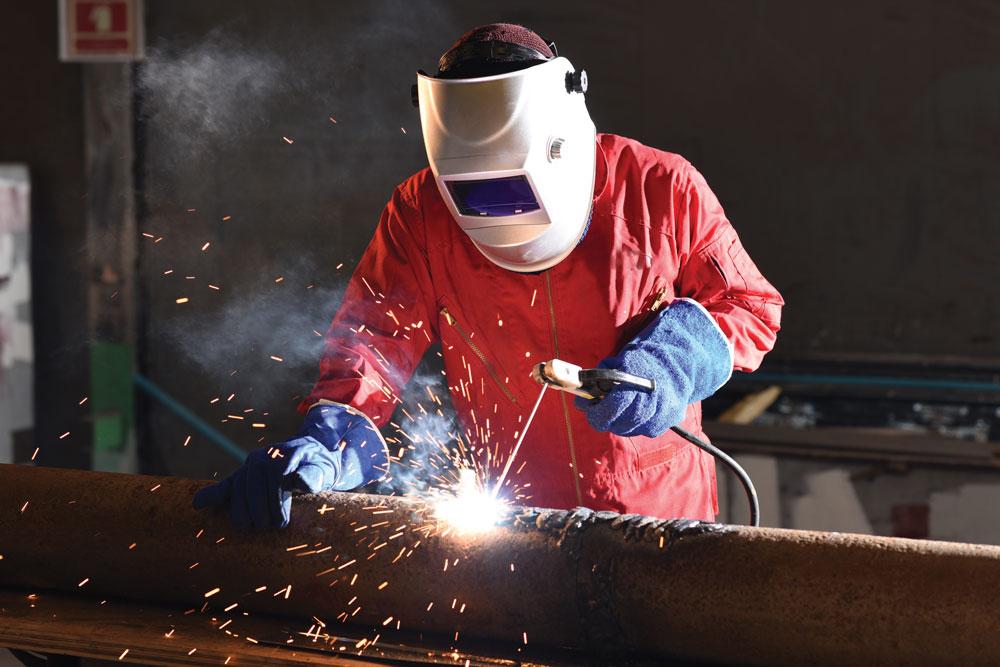Ingenious Approaches to Fillet Weld Assessment and Testing: Enhancing Weld High Quality and Compliance Specifications
In the realm of welding, the quality and honesty of fillet welds play a crucial role in ensuring the structural stability and dependability of various industrial components. With the consistent drive for boosted effectiveness and conformity with rigid standards, the exploration of ingenious strategies to fillet weld examination and screening has ended up being imperative.
Advanced Non-Destructive Testing Approaches
Making use of modern technologies, advanced non-destructive testing approaches play a crucial role in guaranteeing the integrity and top quality of fillet welds. These approaches, such as phased variety ultrasonic screening (PAUT) and magnetic bit testing (MPT), offer thorough understandings into the weld's internal structure without triggering any damage to the material. PAUT, as an example, utilizes several ultrasonic aspects to check the weld from numerous angles, offering a detailed visualization of potential issues like lack of blend or cracks.
Similarly, MPT works in identifying surface-breaking issues by applying a magnetic area and iron particles to the weld location. This method is especially useful for recognizing stoppages that may compromise the weld's toughness. By using these advanced non-destructive screening techniques, weld examiners can properly assess the high quality of fillet welds, making certain compliance with sector criteria and policies. The capacity to spot imperfections beforehand not just improves weld top quality but additionally stops expensive rework or failings in architectural integrity, highlighting the value of these innovative screening approaches in welding inspections.
Robotics and Automation in Examination
The combination of robotics and automation has changed the assessment process for fillet welds, boosting effectiveness and precision in high quality assessment. Robotics supply accurate control and repeatability in inspecting welds, making certain trusted and constant results. Automated systems can be configured to follow details assessment paths, making sure complete coverage of welds and lowering the risk of human error.
Robot evaluation systems equipped with innovative sensing units can discover and measure weld features with high accuracy, providing in-depth data for evaluation. These systems can determine defects such as cracks, absence of fusion, and porosity, allowing prompt restorative activities to be taken. Furthermore, robotics and automation permit for real-time information collection and analysis, providing instant feedback to operators and promoting quick decision-making processes.
In addition, using robotics and automation in fillet weld examination enhances overall efficiency by decreasing assessment times and raising evaluation throughput. By streamlining the assessment procedure, producers can make sure weld top quality and compliance standards are fulfilled efficiently, inevitably causing set you back savings and improved item quality.
Making Use Of Artificial Knowledge for Analysis
Artificial intelligence plays an essential duty in enhancing the performance and accuracy of analysis in fillet weld assessment procedures. By using the power of AI, inspectors can enhance the evaluation of weld high quality and conformity criteria, bring about much more reliable and exact outcomes. AI formulas can rapidly refine huge quantities of information from weld examinations, spotting problems or disparities that may be testing to recognize with the nude eye. This sophisticated modern technology makes it possible for real-time surveillance of weld top quality, enabling for instant restorative activities to be taken if any issues are spotted.
Moreover, AI systems can pick up from past assessment information, continually improving their capacity to determine prospective issues and inconsistencies in fillet welds. This adaptive learning capability boosts the total top quality control process, minimizing the possibility of human mistake and making certain that welds meet the needed requirements. By incorporating artificial intelligence into fillet weld analysis, markets can accomplish greater degrees of performance, uniformity, and conformity in look at here their examination practices.
Portable Tools for On-Site Evaluation
 Enhancing field assessment performance, the adoption of portable tools reinvents on-site assessment processes for fillet welds. These tools provide versatility and comfort, permitting inspectors to carry out detailed examinations in different places, consisting of remote or tough settings. Portable tools such as ultrasonic screening devices, magnetic particle examination equipment, and digital radiography systems offer real-time data and high-resolution imaging capacities, making it possible for fast decision-making and immediate feedback on weld high quality.
Enhancing field assessment performance, the adoption of portable tools reinvents on-site assessment processes for fillet welds. These tools provide versatility and comfort, permitting inspectors to carry out detailed examinations in different places, consisting of remote or tough settings. Portable tools such as ultrasonic screening devices, magnetic particle examination equipment, and digital radiography systems offer real-time data and high-resolution imaging capacities, making it possible for fast decision-making and immediate feedback on weld high quality.One considerable advantage of mobile devices is their capacity to streamline evaluation procedures, minimizing downtime and boosting overall productivity. Examiners can quickly transport these tools to different job sites, eliminating the need for transferring heavy machinery or components to off-site facilities. Furthermore, the mobility of these devices advertises cost-effectiveness by lessening transport costs and increasing examination timelines.
Additionally, the usage of portable devices for on-site examination advertises proactive quality control actions, as examiners can quickly identify and resolve any type of prospective welding defects or disparities. By including these ingenious technologies right into on-site evaluation practices, welding specialists can guarantee conformity with sector requirements and boost weld high quality, ultimately causing improved architectural integrity and safety in different welding applications.
Integration of Information Management Equipment
Having maximized on-site assessment procedures with the utilization of mobile devices, the next phase includes the smooth integration of information administration systems to better improve efficiency and data analysis capacities in fillet weld inspection and testing. Welding Inspection Racine. By incorporating data administration systems right into the inspection process, companies can improve information collection, storage, and evaluation. This integration enables real-time monitoring of weld top quality, immediate recognition of problems, and punctual decision-making to correct any kind of issues that may develop during the evaluation process
The assimilation of information administration systems enables smooth communication in between different stakeholders entailed in the assessment process, promoting collaboration and boosting general quality control actions. Eventually, the integration of information management systems serves to raise the criteria of fillet weld evaluation and screening, guaranteeing conformity with market regulations and improving weld quality.
Verdict
In final thought, innovative strategies to fillet weld assessment and testing have substantially enhanced weld top quality and compliance requirements. Advanced non-destructive screening methods, robotics, automation, expert system, mobile devices, and data administration systems have actually transformed click for info the method weld inspections are carried learn the facts here now out. By making use of these innovations, industries can ensure that welds meet the needed top quality standards and guidelines, inevitably improving overall effectiveness and security in welding procedures.

By utilizing these innovative non-destructive screening strategies, weld assessors can precisely evaluate the high quality of fillet welds, making sure conformity with market requirements and guidelines. Portable devices such as ultrasonic testing gadgets, magnetic bit assessment devices, and digital radiography systems supply real-time information and high-resolution imaging capacities, making it possible for fast decision-making and prompt responses on weld top quality.
Having actually optimized on-site inspection processes through the application of mobile devices, the next phase entails the smooth combination of data management systems to even more enhance efficiency and information evaluation abilities in fillet weld inspection and screening (Welding Inspection Racine). Eventually, the integration of information monitoring systems serves to elevate the criteria of fillet weld examination and screening, guaranteeing conformity with sector policies and improving weld quality
 In verdict, ingenious methods to fillet weld evaluation and screening have actually substantially enhanced weld top quality and conformity requirements.
In verdict, ingenious methods to fillet weld evaluation and screening have actually substantially enhanced weld top quality and conformity requirements.
Comments on “Welding Inspection Racine: Making Certain Precision and Dependability in Every Weld”